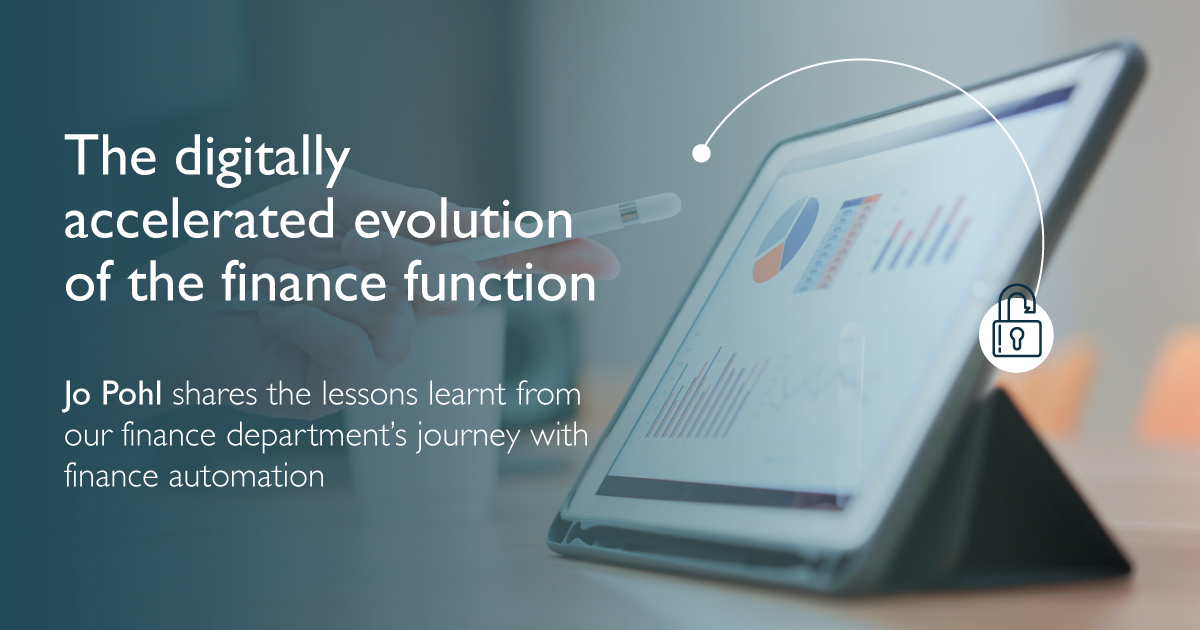Whichever way you look at it, automation has become a feature of the finance function – a very positive one at that.
In 2014 research from McKinsey Global Institute estimated that activities comprising 34% of a financial manager’s time could be automated by adapting current technologies, freeing up finance professionals for more strategic activities. Executives sat up and listened. Fast forward seven years and according to a PWC report, 75% of CFOs said they plan to allocate more resources to digital transformation in 2021. The future is now.
In essence, if all finance professionals are doing is collecting data or performing rote tasks, then we are constantly looking out of the rear-view mirror versus the windscreen. The increased focus on process automation reflects the many benefits that can be realised along the digital transformation journey to ensure investment in digitisation delivers a good return. Automation allows the finance function to improve its data and analytics competencies, adopt new tools, deliver better flexibility and agility, and enhance the business value it provides by turning data into insights to support making informed decisions quickly – ultimately improving overall sustainability and profitability.
Automation thus enables finance professionals to shift their focus to the strategic dimensions of their role.
iOCO’s journey
Finance automation is a journey where every step towards improving the user experience or delivering a more optimised or seamless process is innovation. To make this real and practical, I’m going to share aspects of iOCO’s own finance automation journey – our approach, what worked, what didn’t. It hasn’t been easy, but we’ve learnt a lot and achieved an enormous amount.
EOH is a business that grew through acquisition over 20 years. However, we didn’t integrate the 272 entities into clusters of similar businesses with aligned processes and systems. This led to inefficiencies and a lack of standardisation across the enterprise.
A lot has happened over the last few years. We have a new leadership team, a well-established and robust governance framework and an appetite for renewal and growth. We have successfully articulated our new business strategy in a relatively short time, and as data, technology, and compliance complexity grow, we have invested in how we align the back office with the front-end.
It’s said that innovation is often born out of a pain point. We took a step back to understand the pain points right at the beginning – this was not about (wo)man versus the machine but rather an automation and people programme.
As a consequence of first identifying the pain points, for example legacy systems, paper-based and cumbersome manual processes, when we called all the critical finance teams together, the process became about solving for the way forward collectively. This meant that the buy-in came out of a direct correlation between what would improve the user experience and Finance’s ability to deliver as operators, catalysts, stewards and strategists for the business.
It made sense for Finance itself to originate the project to systemise and digitise the finance function. But we couldn’t simply systemise the finance functions. We had to look at the broader ecosystem of business processes that finance supports.
Deciding which technologies to use, and which providers of these technologies to work with, is a process all on its own. When evaluating the underlying technologies and the implications for your business, take time to identify the best in class and then create a shortlist of options that suit your context and what exactly you’re trying to solve for – fit-for-purpose perhaps?
If it’s routine tasks, you need robotic process automation. If it’s about insights and analytics, you probably need data mining, conversational agents and chatbots. If it’s optimisation, then process mining will help you understand where the gaps are from the perspective of operational effectiveness.
And keep in mind that it won’t be a one-size-fits-all situation – for us it’s transformation through collaboration. The answers you need depend on the business context – what your business does, where your business operates, the stage of maturity and your particular pain points.
What we learnt
What would we do differently? I don’t think we would change the approach to the process, but we would probably have been a little less optimistic about how long the design phase takes. In the end we had to slow down to speed up: it’s essential to spend the time upfront clarifying your goals and ensuring that all the dots (key input) are collected and connected.
As you can imagine, there’s a very significant people component to this process. Successful implementation is critically reliant on people taking ownership of their roles and work streams. If you don’t get the foundation right and take the time to get people on board, you will start this journey and leave some behind. The team needs to be as committed as you are.
My advice is to understand what you are trying to do, get the business to join you on your journey, and take the time to do the planning up-front before you start getting vendors involved. It’s complex; it’s difficult – we get it. This is a call to those on the fence – start the digital transformation journey and build on it until everyone understands and believes in where you are all going. It will gather its own momentum.
Place finance at the centre
Automation is not an end in itself but rather a means to an end. Automation, machine learning, and robotics are forcing the finance function to be more disciplined, deliberate, and to execute – from a system-agnostic perspective – on a more effective and efficient basis.
In our case we’ve seen mindsets shift amongst our finance professionals, who now understand the potential of their new roles and that future-proofing finance also future proofs ourselves – as value-adding partners rather than simple number crunchers.



